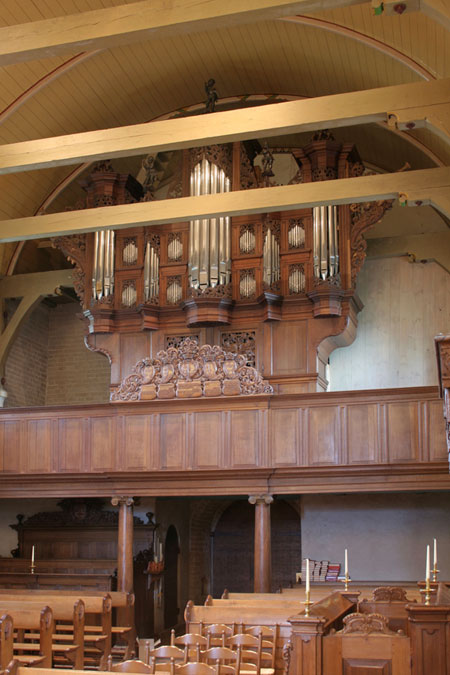Garrels-Radeker orgel
 Het Radeker-Garrels orgel is in 1717 aan de kerk geschonken door de familie Ellents. Men heeft de bouw van het orgel gegund aan Johannes Radeker en Rudolf Garrels. Beiden zijn meesterknechten van Arp Schnitger. Schnitger had een werkplaats in de Gelkingerstraat in Groningen. Op 5 maart 1717 is de akte van aanbesteding ondertekend. De prijs van het orgel: 1.450 Carolusguldens. 16 oktober 1718 wordt er voor het eerst op gespeeld.
Het Radeker-Garrels orgel is in 1717 aan de kerk geschonken door de familie Ellents. Men heeft de bouw van het orgel gegund aan Johannes Radeker en Rudolf Garrels. Beiden zijn meesterknechten van Arp Schnitger. Schnitger had een werkplaats in de Gelkingerstraat in Groningen. Op 5 maart 1717 is de akte van aanbesteding ondertekend. De prijs van het orgel: 1.450 Carolusguldens. 16 oktober 1718 wordt er voor het eerst op gespeeld.
Op 6 maart 1944 begint orgelbouwer Mense Ruiter een grootscheepse restauratie, die in 1950 is afgerond. Restauratie is eigenlijk niet het juiste woord, omdat het orgel niet in authentieke staat is teruggebracht. Hoewel het orgel naar de toen geldende opvattingen zorgvuldig is gerestaureerd, plaatst men tegenwoordig de artistieke kant van deze restauratie in een ander daglicht. Omdat het een orgel uit de Schitgerschool is, zou het ook zo moeten klinken.
Door initiatieven van de Stichting Muziek in Anloo kon in de jaren negentig het orgel opnieuw gerestaureerd worden. De stichting zorgde er voor dat het Radeker-Garrelsorgel, gerestaureerd werd conform het bestek uit 1717. Juni 2001 kon het weer in gebruik kon worden genomen. De eindkeuring door prof. dr. Harald Vogel vond plaats op 15 maart 2002.
De restauratie van het orgel in de jaren negentig
Henk van Eeken, orgelmaker te Herwijnen, restaureerde samen met zijn medewerkers het orgel. De start van de restauratie was in 1990. Doel: een zo zorgvuldig mogelijk herstel van de oorspronkelijke toestand. Uitgangspunt was het bestek uit 1717. Nadat echter in 1995 bij een noodlottige brand in de werkplaats van de orgelmaker een groot deel van het pijpwerk verloren was gegaan, kwam er veel meer nadruk te liggen op reconstructie van het orgel.
 Het orgel werd eind jaren negentig opgeleverd, waarna nog een vrijbespeelbaar pedaal werd gemaakt. In 2002 werd dat opgeleverd. Het zelfstandig pedaal heeft vier registers. Het heeft een trapinrichting. In 1717 was er nog geen elektriciteit. De dorpsonderwijzer was meestal voorzanger en orgeltrapper. Een zware klus om lucht in het orgel te pompen.
Het orgel werd eind jaren negentig opgeleverd, waarna nog een vrijbespeelbaar pedaal werd gemaakt. In 2002 werd dat opgeleverd. Het zelfstandig pedaal heeft vier registers. Het heeft een trapinrichting. In 1717 was er nog geen elektriciteit. De dorpsonderwijzer was meestal voorzanger en orgeltrapper. Een zware klus om lucht in het orgel te pompen.
De oorspronkelijke klank van het instrument is door de restauratie en reconstructie nagenoeg teruggehaald. Van beslissende betekenis voor de restauratie en reconstructie van het Radeker-Garrelsorgel is de betrokkenheid van Henk van Eeken bij GOArt geweest, het 'Göteborg Organ Art Center' geweest. GOArt is een internationaal onderzoekscentrum voor orgelgeschiedenis, orgelbouw, onderwijs en uitvoeringspraktijk van de universiteit van Gotenburg in Zweden.
Door onder andere wetenschappelijk onderzoek worden bij GOArt tal van processen en werkwijzen uit de orgelbouwgeschiedenis gereconstrueerd en op hun waarde en betrouwbaarheid beoordeeld. Een breed, internationaal forum van deskundigen participeert in dit onderzoek.
Herontdekte kennis en vaardigheden zijn door Van Eeken gebruikt bij de restauratie van het Anlooër orgel. Zo konden voor het eerst sinds lange tijd nieuwe orgelpijpen volledig volgens de oorspronkelijke werkwijze uit 1717 worden gemaakt:
het orgelmetaal werd op een zandbed uitgegoten en de platen werden uitsluitend met de hand afgeschaafd om de juiste dikte te krijgen.
(Stemming: Arp Schnitger, zoals toegepast bij het Hus-orgel in de St. Cosmae in Stade, Duitsland.)
Dispositie:
Manuel:
|
Principael |
8’ |
|
Quintadena |
16’ |
|
Roerpijp |
8’ |
|
Octav |
4’ |
|
Spitspijp |
4’ |
|
Quint |
3’ |
|
Super Octav |
2’ |
|
Sexquialter |
2 sterk |
|
Mixtuir |
4-5-6- sterk |
|
Trompet |
8’ |
|
Vox Humana |
8’ |
Borstpositiff:
|
Gedackt |
8’ |
|
Floit |
4’ |
|
Octav |
2’ |
|
Sijfloit |
1 1/2’ |
|
Scherp |
3 sterk |
|
Dulciaen |
8’ |
Pedael:
Bardon 16'
Octaaf 8'
Basuyn 16'
Cornet 4



